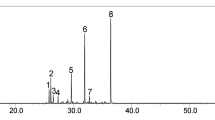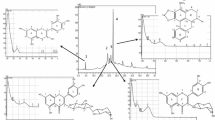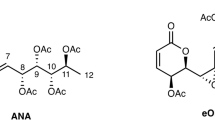Abstract
D-002, a mixture of six higher aliphatic alcohols purified from beeswax, displayed anti-inflammatory effects in carrageenan-induced pleurisy and cotton pellet granuloma in rats. The aim of the present study was to confirm the anti-inflammatory properties of D-002 and to explore its potential analgesic effects. Xylene-induced mouse ear oedema was used to assess the anti-inflammatory effect, acetic acid-induced writhing and hot plate responses for the analgesic activity, and the open field and horizontal rotarod tests for motor performance. For anti-inflammatory tests, mice were randomised into a negative vehicle control and five xylene-treated groups: the vehicle, D-002 (25, 50 and 200 mg/kg) and indomethacin 1 mg/kg (reference drug). Treatments were given for 15 days. Effects on oedema formation and myeloperoxidase (MPO) activity were tested. For analgesia and motor performance tests, mice were randomised into a vehicle control and D-002-treated groups (25, 50 and 200 mg/kg). Two sets of experiments were done, which included acute and repeat (15 days) dosing. D-002 (25, 50 and 200 mg/kg) significantly decreased xylene-induced ear oedema (44.7, 60.8 and 76.4%, respectively) and the increase of MPO activity induced by xylene (38.0, 47.0 and 57.0%, respectively), while indomethacin significantly inhibited xylene-induced oedema (59.9%) and MPO activity (57.5%). Single and repeat doses of D-002 (25, 50 and 200 mg/kg) decreased the acetic acid-induced writhing responses by 21.2, 28.2 and 40.1%, for the single doses; 25.2, 35.1 and 43.2%, respectively, for the repeat doses, but did not affect the hot plate, open field and rotarod behaviours. Aspirin 100 mg/kg significantly decreased acetic acid-induced abdominal constrictions and morphine (5 mg/kg) significantly increased the latency of the hot plate response. This study confirmed the anti-inflammatory effects of D-002 and demonstrated its analgesic effects on the acetic acid-induced writhing, but not on the hot plate response, which suggests that the antinociceptive effects of D-002 could be related to its anti-inflammatory activity.
Similar content being viewed by others
References
Wierda RJ, Geutskens SB, Jukema JW, Quax PH, van den Elsen PJ (2010) Epigenetics in atherosclerosis and inflammation. J Cell Mol Med 30:1225–1240
Gokkusu CF, Tulubas F, Unlucerci Y, Ozkok E, Umman B, Aydin M (2010) Homocysteine and pro-inflammatory cytokine concentrations in acute heart disease. Cytokine 50:15–18
Abdel-Meguid TA, Mosli HA, Al-Maghrabi JA (2009) Prostate inflammation: association with benign prostatic hyperplasia and prostate cancer. Saudi Med J 30:1563–1567
Valdés AM, Spector TD (2010) The clinical relevance of genetic susceptibility to osteoarthritis. Best Pract Res Clin Rheumatol 24(1):3–14
Yajima H, Yamao J, Fukui H, Takakura Y (2007) Up-to-date information on gastric mucosal lesions from long-term NSAID therapy in orthopaedic outpatients: a study using logistic regression analysis. J Orthop Sci 12:341–346
Singh G (2000) Gastrointestinal complications of prescription and over-the-counter non-steroidal anti-inflammatory drugs: a view from the ARAMIS database. Am J Ther 7:115–121
Más R (2001) D-002: a product obtained from beeswax. Drugs Future 26:731–744
Carbajal D, Molina V, Valdés S, Arruzazabala ML, Más R, Magraner J (1998) Anti-inflammatory activity of D-002: an active product isolated from beeswax. Prostagl Leukotr Essent Fatty Acids 59:235–238
Carbajal D, Molina V, Valdés S, Arruzazabala ML, Más R (1995) Anti-ulcer activity of higher primary alcohols of beeswax. J Pharm Phamacol 47:731–733
Carbajal D, Molina V, Valdés S, Arruzazabala ML, Rodeiro I, Más R, Magraner J (1996) Possible cytoprotective mechanism in rats of D-002 an anti-ulcerogenic product isolated from beeswax. J Pharm Pharmacol 48:858–860
Carbajal D, Molina V, Noa M, Valdés S, Arruzazabala ML, Aguiar A, Más R (2000) Effects of D-002 on gastric mucus composition in ethanol-induced ulcer. Pharmacol Res 42:329–332
Molina V, Valdés S, Carbajal D, Arruzazabala ML, Menéndez R, Más R (2001) Antioxidant effects of D-002 on gastric mucosa of rats with experimentally-induced injury. J Med Food 4:79–83
Molina V, Carbajal D, Arruzazabala ML, Más R (2005) Therapeutic effect of D-002 (Abexol) on gastric ulcer induced experimentally in rats. J Med Food 18:59–62
Hano O, Illnait J, Más R, Fernández L, Piñol F, Fernández J (2001) Effects of D-002, a product isolated from beeswax, on duodenal ulcer: a double-blind, placebo-controlled study. Curr Ther Res 62:394–407
Illnait J, Terry H, Más R, Fernández L, Carbajal D (2005) Effects of D-002, a product isolated from beeswax, on gastric symptoms of patients with osteoarthritis treated with piroxicam: a pilot study. J Med Food 8:63–68
Rodríguez I, Illnait J, Terry H, Más R, Fernandez L, Fernández JC, Gámez R, Mesa M, Mendoza S, Ruiz D, Cruz Y (2009) Effects of Abexol® (beeswax alcohols) on gastrointestinal symptoms of middle-aged and older subjects. Rev CENIC Cien Biol 40:147–154
Lin S, Zhang H, Han T, Wu J, Rahman K, Qin L (2007) In vivo effect of casticin on acute inflammation. J Chin Integr Med 5:1–4
Junping K, Yun N, Wang N, Liang L, Zhi-Hong H (2005) Analgesic and anti-inflammatory activities of total extract and individual fractions of Chinese medicinal plants Polyrhachis lamellidens. Biol Pharm Bull 28:176–180
Stepanovic-Petrovic RM, Tomic MA, Vuckovic SM, Paranos S, Ugresic ND, Prostran MS, Milovanovic S, Boskovic B (2008) The antinociceptive effects of anticonvulsants in a mouse visceral pain model. Anesth Analg 106:1897–1990
Chiba S, Nishiyama T, Yoshikawa M, Yamada Y (2009) The antinociceptive effects of midazolam on three different types of nociception in mice. J Pharmacol Sci 109:71–77
Boyce-Rustay JM, Honore P, Jarvis MF (2010) Animal models of acute and chronic inflammatory and nociceptive pain. Methods Mol Biol 617:41–55
González V, Marrero D, Sierra R, Velázquez C, Vicente R (2008) Nuevo método por cromatografía gaseosa capilar para el análisis del ingrediente activo D-002. Rev CENIC Cien Quim 39:123–125
Worthington Biochemical Corp (1972) Worthington enzyme manual. Worthington Biochemical Corp, New Jersey, pp 43–45
Lu TC, Ko YZ, Huang HW, Hung YC, Lin YC, Peng WH (2007) Analgesic and anti-inflammatory activities of aqueous extract from Glycine tomentella root in mice. J Ethnopharmacol 113:142–148
Holzer P, Jurna I, Gambe R, Lembeck F (1979) Nociceptive threshold after neonatal capsaicin treatment. Eur J Pharmacol 58:511–514
Fernández L, Pérez H, Más R (1987) Efectos de Justicia pectoralis sobre la conducta exploratoria en ratones. En Estudios Avanzados en Neurociencias. CENIC, Cuba, pp 257–264
Coughenour L, McLean J, Parker R (1977) A new device for the rapid measurement of impaired motor function in mice. Pharmacol Biochem Behavior 6:351–355
van der Veen BS, de Winther MP, Heeringa P, Augusto O, Chen JW, Davies M, Ma XL, Malle E, Pignatelli P, Rudolph T (2009) Myeloperoxidase: molecular mechanisms of action and their relevance to human health and disease. Antioxid Redox Signal 11:2899–2937
Menéndez R, Amor AM, González RM, Jiménez S, Más R (2000) Inhibition of rat microsomal lipid peroxidation by the oral administration of D-002. Braz J Med Biol Res 33:85–90
Pérez Y, Gonzalez RM, Amor AM, Jiménez S, Menéndez R (2002) D-002 on antioxidant enzymes in liver and brain of rats. Rev CENIC Cien Biol 33:3–5
Menéndez R, Más R, Amor AM, Perez Y, González RM, Fernández JC, Jiménez S (2001) Antioxidant effects of D-002 on the in vitro susceptibility in healthy volunteers. Arch Med Res 32:436–441
Menéndez R, Más R, Illnait J, Pérez J, Amor AM, Fernández JC, González RM (2001) Effects of D-002 on lipid peroxidation in older subjects. J Med Food 4:71–77
López E, Illnait J, Molina V, Oyarzábal A, Fernández L, Pérez Y, Más R, Mesa M, Fernández JC, Mendoza S, Gámez R, Jiménez S, Ruiz D, Jardines Y (2008) Effects of D-002 (beeswax alcohols) on lipid peroxidation in middle-aged and older subjects. LAJP 27:695–703
Rodriguez I, Illnait J, Molina V, Oyarzabal A, Fernández L, Fernández JC, Mesa M, Más R, Mendoza S, Gámez R, Jimenez Sy, Ruiz D (2009) Comparison of the antioxidant effects of D-002 (beeswax alcohols) and grape seed extract (GSE) on plasma oxidative variables in healthy subjects. LAJP 29:255–262
Koo HJ, Lim KH, Jung HJ, Park EH (2006) Anti-inflammatory evaluation of gardenia extract, geniposide and genipin. J Ethnopharmacol 103:496–500
Oliveira FA, Costa CL, Chaves MH, Almeida FR, Cavalcante IJ, Lima AF, Lima RC Jr, Silva RM, Campos AR, Santos FA (2005) Attenuation of capsaicin-induced acute and visceral nociceptive pain by alpha-and beta-amyrin, a triterpene mixture isolated from Protium heptaphyllum resin in mice. Life Sci 77:2942–2952
File SE (1987) The contribution of behavioural studies to the neuropharmacology of anxiety. Neuropharmacology 26:877–886
Monville C, Torres EM, Dunnett SB (2006) Comparison of incremental and accelerating protocols of the rotarod test for the assessment of motor deficits in the 6-OHDA model. J Neurosci Methods 158:219–223
Author information
Authors and Affiliations
Corresponding author
Rights and permissions
About this article
Cite this article
Ravelo, Y., Molina, V., Carbajal, D. et al. Evaluation of anti-inflammatory and antinociceptive effects of D-002 (beeswax alcohols). J Nat Med 65, 330–335 (2011). https://doi.org/10.1007/s11418-010-0496-4
Received:
Accepted:
Published:
Issue Date:
DOI: https://doi.org/10.1007/s11418-010-0496-4




